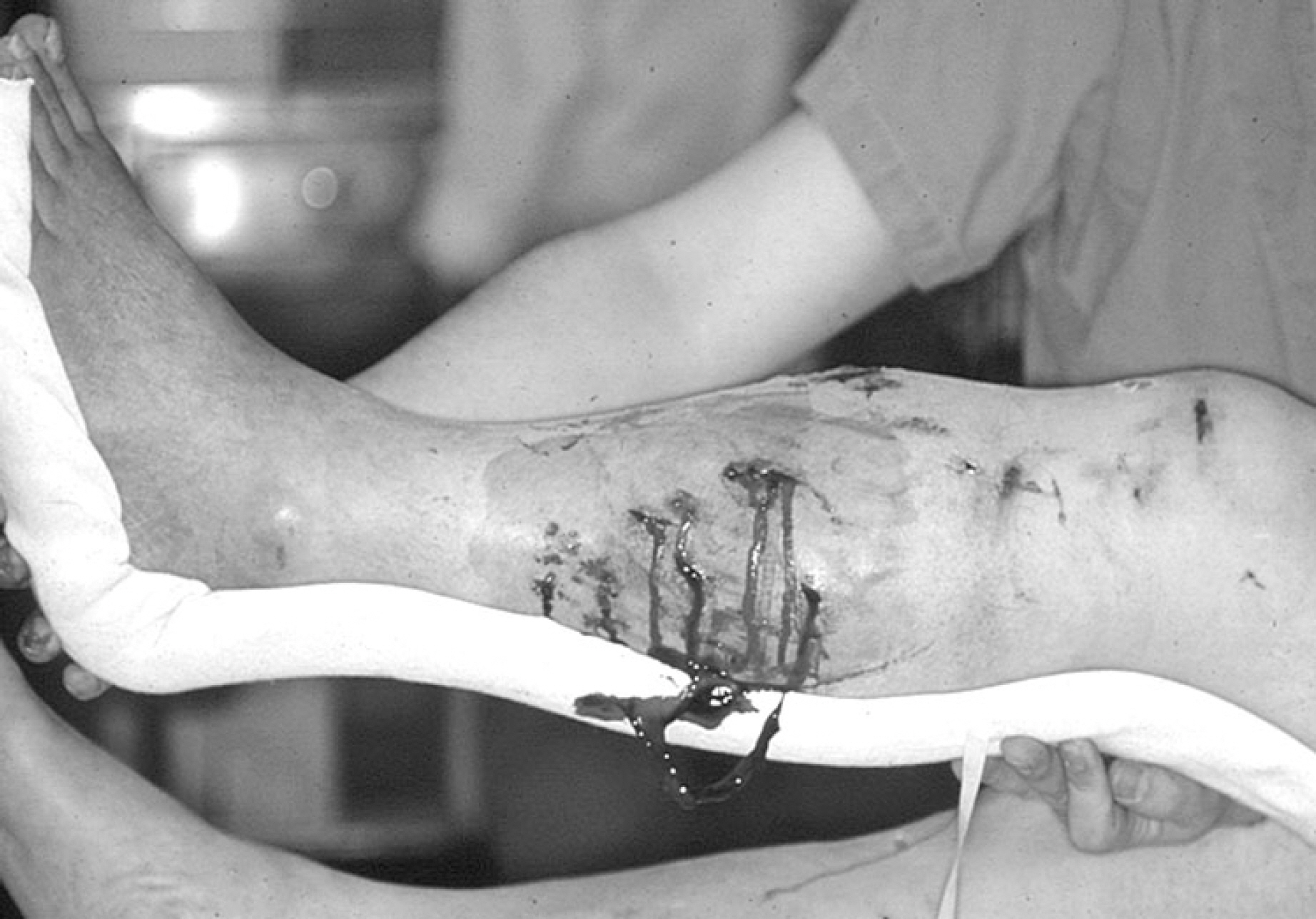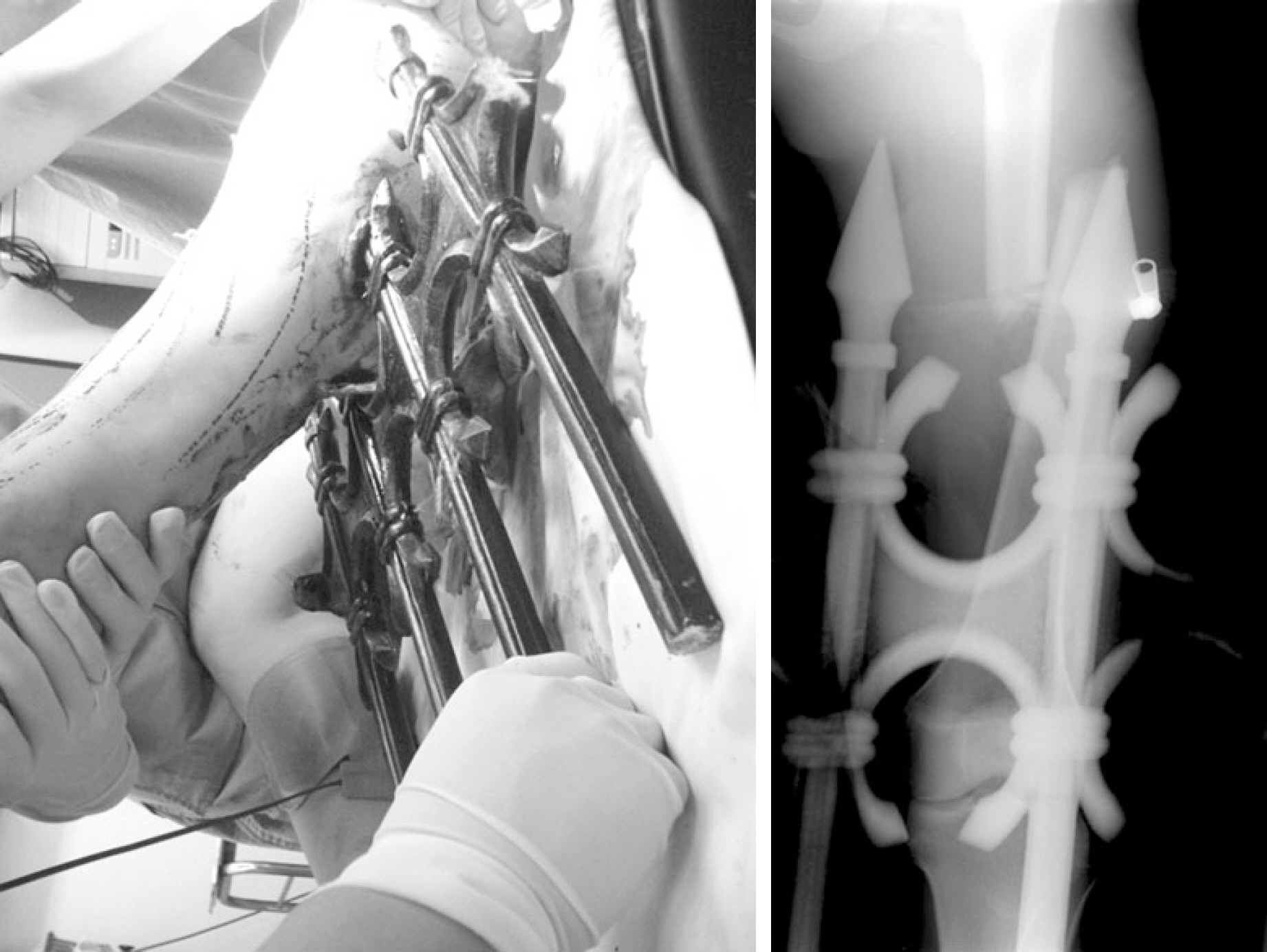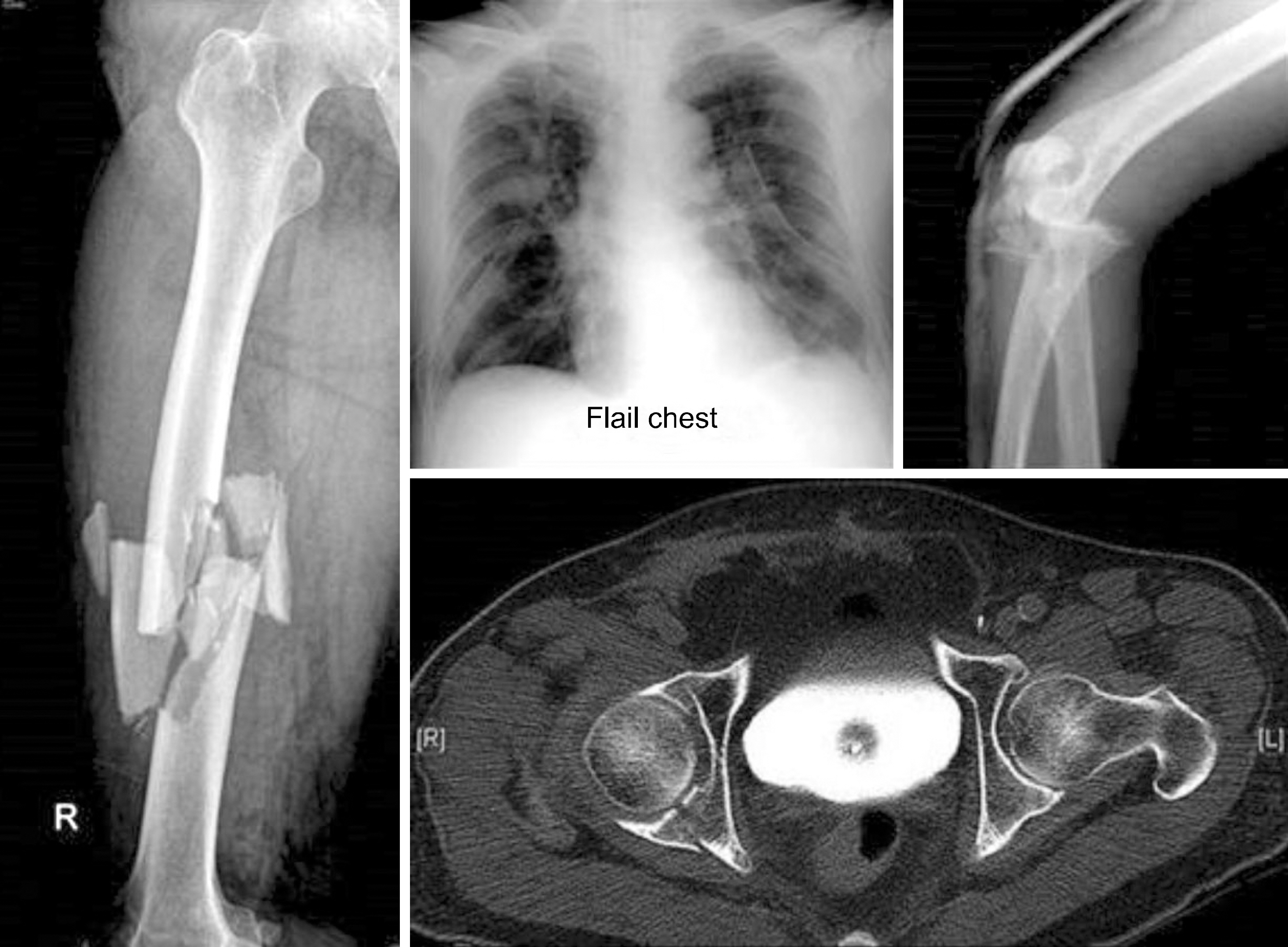Articles
- Page Path
- HOME > J Musculoskelet Trauma > Volume 28(2); 2015 > Article
-
Review Article
- Surgical Timing of Treating Adult Trauma: Emergency/Urgency
- Dong-Hyun Kang, M.D., Kyu Hyun Yang, M.D., Ph.D.
-
Journal of the Korean Fracture Society 2015;28(2):139-145.
DOI: https://doi.org/10.12671/jkfs.2015.28.2.139
Published online: January 10, 2015
Department of Orthopedic Surgery, Gangnam Severance Hospital, Yonsei University College of Medicine, Seoul, Korea
- Address reprint requests to: Kyu Hyun Yang, M.D., Ph.D. Department of Orthopaedic Surgery, Yonsei University Gangnam Severance Hospital, 211 Eonjuro, Gangnam-gu, Seoul 135-720, Korea Tel: 82-2-2019-3414ㆍFax: 82-2-573-5393 E-mail: kyang@yuhs.ac
Copyright © 2015 The Korean Fracture Society
This is an Open Access article distributed under the terms of the Creative Commons Attribution Non-Commercial License (http://creativecommons.org/licenses/by-nc/3.0) which permits unrestricted non-commercial use, distribution, and reproduction in any medium, provided the original work is properly cited.
- 282 Views
- 0 Download
Fig. 1.Acute compartment syndrome in lower extremity with open fracture. We can observe the venous congestion around the foot.


Fig. 2.An example of an open fracture because of fall. The patient needs early debridement and fixation. A case of open femur fracture due to fall from the roof.


Fig. 3.Regional x-rays of a polytrauma patient. We can observe severe comminuted fracture of femur diaphysis and elbow. The acetabular fracture and flail chest can also be seen.


Table 1.The Abbreviated Injury Scale (AIS) and an Example of Scoring Each Element according to Injury
- 1). The Korean Fracture Society: Principles of fracture management. 1st ed.Seoul; Pan Mun Education: 2013.
- 2). Oh HK. General assessment and initial management of polytrauma patients. J Korean Fract Soc, 26:230-240. 2013.Article
- 3). Crist BD, Ferguson T, Murtha YM, Lee MA. Surgical timing of treating injured extremities: an evolving concept of urgency. Instr Course Lect, 62:17-28. 2013.
- 4). McQueen MM, Christie J, Court-Brown CM. Acute compartment syndrome in tibial diaphyseal fractures. J Bone Joint Surg Br, 78:95-98. 1996.ArticlePDF
- 5). Matava MJ, Whitesides TE Jr, Seiler JG 3rd, Hewan-Lowe K, Hutton WC. Determination of the compartment pressure threshold of muscle ischemia in a canine model. J Trauma, 37:50-58. 1994.Article
- 6). Lee KB, Lee SH. Diagnosis and management of acute compartment syndrome. J Korean Fract Soc, 28:93-101. 2015.Article
- 7). McQueen MM, Court-Brown CM. Compartment monitoring in tibial fractures. The pressure threshold for decompression. J Bone Joint Surg Br, 78:99-104. 1996.
- 8). Finkelstein JA, Hunter GA, Hu RW. Lower limb compartment syndrome: course after delayed fasciotomy. J Trauma, 40:342-344. 1996.
- 9). Mills WJ, Barei DP, McNair P. The value of the ankle-brachial index for diagnosing arterial injury after knee dislocation: a prospective study. J Trauma, 56:1261-1265. 2004.Article
- 10). Bynoe RP, Miles WS, Bell RM, et al. Noninvasive diagnosis of vascular trauma by duplex ultrasonography. J Vasc Surg, 14:346-352. 1991.Article
- 11). Rieger M, Mallouhi A, Tauscher T, Lutz M, Jaschke WR. Traumatic arterial injuries of the extremities: initial evaluation with MDCT angiography. AJR Am J Roentgenol, 186:656-664. 2006.Article
- 12). Hafez HM, Woolgar J, Robbs JV. Lower extremity arterial injury: results of 550 cases and review of risk factors associated with limb loss. J Vasc Surg, 33:1212-1219. 2001.
- 13). Barei DP, Nork SE, Mills WJ, Henley MB, Benirschke SK. Complications associated with internal fixation of high-energy bicondylar tibial plateau fractures utilizing a two-incision technique. J Orthop Trauma, 18:649-657. 2004.Article
- 14). Rihn JA, Groff YJ, Harner CD, Cha PS. The acutely dislocated knee: evaluation and management. J Am Acad Orthop Surg, 12:334-346. 2004.Article
- 15). Robson MC, Duke WF, Krizek TJ. Rapid bacterial screening in the treatment of civilian wounds. J Surg Res, 14:426-430. 1973.Article
- 16). Gristina AG, Costerton JW. Bacterial adherence to biomaterials and tissue. The significance of its role in clinical sepsis. J Bone Joint Surg Am, 67:264-273. 1985.
- 17). Gristina AG, Naylor PT, Webb LX. Molecular mechanisms in musculoskeletal sepsis: the race for the surface. Instr Course Lect, 39:471-482. 1990.
- 18). Gristina AG, Oga M, Webb LX, Hobgood CD. Adherent bacterial colonization in the pathogenesis of osteomyelitis. Science, 228:990-993. 1985.
- 19). Gristina AG, Naylor PT, Myrvik QN. Mechanisms of musculoskeletal sepsis. Orthop Clin North Am, 22:363-371. 1991.
- 20). Werner CM, Pierpont Y, Pollak AN. The urgency of surgical débridement in the management of open fractures. J Am Acad Orthop Surg, 16:369-375. 2008.
- 21). Swiontkowski MF, Winquist RA, Hansen ST Jr. Fractures of the femoral neck in patients between the ages of twelve and forty-nine years. J Bone Joint Surg Am, 66:837-846. 1984.
- 22). Protzman RR, Burkhalter WE. Femoral-neck fractures in young adults. J Bone Joint Surg Am, 58:689-695. 1976.
- 23). Haidukewych GJ, Rothwell WS, Jacofsky DJ, Torchia ME, Berry DJ. Operative treatment of femoral neck fractures in patients between the ages of fifteen and fifty years. J Bone Joint Surg Am, 86:1711-1716. 2004.
- 24). Jain R, Koo M, Kreder HJ, Schemitsch EH, Davey JR, Mahomed NN. Comparison of early and delayed fixation of subcapital hip fractures in patients sixty years of age or less. J Bone Joint Surg Am, 84:1605-1612. 2002.
- 25). Gautier E, Ganz K, Krügel N, Gill T, Ganz R. Anatomy of the medial femoral circumflex artery and its surgical implications. J Bone Joint Surg Br, 82:679-683. 2000.
- 26). Sevitt S, Thompson RG. The distribution and anastomoses of arteries supplying the head and neck of the femur. J Bone Joint Surg Br, 47:560-573. 1965.
- 27). Upadhyay A, Jain P, Mishra P, Maini L, Gautum VK, Dhaon BK. Delayed internal fixation of fractures of the neck of the femur in young adults. A prospective, randomised study comparing closed and open reduction. J Bone Joint Surg Br, 86:1035-1040. 2004.
- 28). Liporace F, Gaines R, Collinge C, Haidukewych GJ. Results of internal fixation of Pauwels type-3 vertical femoral neck fractures. J Bone Joint Surg Am, 90:1654-1659. 2008.
- 29). Tooke SM, Favero KJ. Femoral neck fractures in skeletally mature patients, fifty years old or less. J Bone Joint Surg Am, 67:1255-1260. 1985.
- 30). Bray TJ. Femoral neck fracture fixation. Clinical decision making. Clin Orthop Relat Res, 339:20-31. 1997.
- 31). Scheck M. Intracapsular fractures of the femoral neck. Comminution of the posterior neck cortex as a cause of unstable fixation. J Bone Joint Surg Am, 41:1187-1200. 1959.
- 32). Song HK, Lee JJ, Oh HC, Yang KH. Clinical implication of subgrouping in valgus femoral neck fractures: comparison of 31-B1.1 with 31-B1.2 fractures using the OTA/AO classification. J Orthop Trauma, 27:677-682. 2013.
- 33). Hawkins LG. Fractures of the neck of the talus. J Bone Joint Surg Am, 52:991-1002. 1970.
- 34). Canale ST, Kelly FB Jr. Fractures of the neck of the talus. Long-term evaluation of seventy-one cases. J Bone Joint Surg Am, 60:143-156. 1978.
- 35). Vallier HA, Nork SE, Barei DP, Benirschke SK, Sangeorzan BJ. Talar neck fractures: results and outcomes. J Bone Joint Surg Am, 86:1616-1624. 2004.
- 36). Tuttle MS, Smith WR, Williams AE, et al. Safety and efficacy of damage control external fixation versus early definitive stabilization for femoral shaft fractures in the multiple-injured patient. J Trauma, 67:602-605. 2009.
REFERENCES
Figure & Data
REFERENCES
Citations
Citations to this article as recorded by 

Surgical Timing of Treating Adult Trauma: Emergency/Urgency



Fig. 1. Acute compartment syndrome in lower extremity with open fracture. We can observe the venous congestion around the foot.
Fig. 2. An example of an open fracture because of fall. The patient needs early debridement and fixation. A case of open femur fracture due to fall from the roof.
Fig. 3. Regional x-rays of a polytrauma patient. We can observe severe comminuted fracture of femur diaphysis and elbow. The acetabular fracture and flail chest can also be seen.
Fig. 1.
Fig. 2.
Fig. 3.
Surgical Timing of Treating Adult Trauma: Emergency/Urgency
The Abbreviated Injury Scale (AIS) and an Example of Scoring Each Element according to Injury
| AIS example | Score |
|---|---|
| Head | |
| Head or brain crushing injury | 6 |
| Extradural hemorrhage | 4 |
| Facial | |
| External carotid artery rupture | 3 |
| LeFort III fracture | 3 |
| Cervical | |
| Thyroid contusion | 1 |
| Laryngeal crushing injury | 5 |
| Thoracic | |
| Bilateral lung contusion | 4 |
| Rib fractures more than 2–3 | 2 |
| Abdominal and pelvic organ | |
| Bladder rupture | 4 |
| Spleen rupture | 4 |
| Liver laceration >20% bleeding | 3 |
| Spine | |
| Complete paralysis below C4 | 5 |
| Vertebral body compression ratio >20% | 3 |
| Upper extremity | |
| Open forearm fracture | 3 |
| Shoulder dislocation | 2 |
| Lower extremity | |
| Open pelvic ring injury | 3 |
| Amputation at thigh | 4 |
| Femur fracture | 3 |
| External | |
| Hypothermia <31°C | 3 |
Table 1. The Abbreviated Injury Scale (AIS) and an Example of Scoring Each Element according to Injury

 E-submission
E-submission KOTA
KOTA TOTA
TOTA TOTS
TOTS
 Cite
Cite

